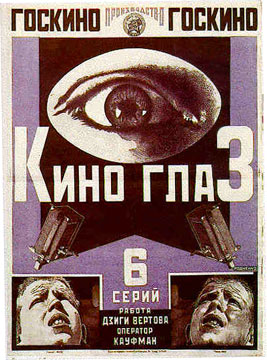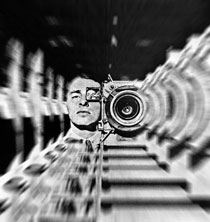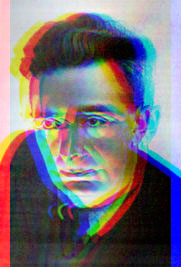I yam what I yam
5 Feb 2005
"I am kino-eye, I am mechanical eye. I, a machine, show you the world as only I can see it."
Excerpt from Kino Eye manifesto, 10 April 1923 – Dziga Vertov
 Between the years 1922 and 1945 Russian filmmaker Dziga Vertov devoted most of his writing to the subject of cinema and cultural revolutions. Vertov was interested in the politics of cinema and how the monocular optics of a camera might view the world differently than the lens in a human eye. He called this monocular vision "Kino eye" or "Kino Pravda," that is, camera eye or camera truth.
Between the years 1922 and 1945 Russian filmmaker Dziga Vertov devoted most of his writing to the subject of cinema and cultural revolutions. Vertov was interested in the politics of cinema and how the monocular optics of a camera might view the world differently than the lens in a human eye. He called this monocular vision "Kino eye" or "Kino Pravda," that is, camera eye or camera truth.
As an artist, Vertov first came to prominence in the mid 1920's during a particularly dynamic moment in post-civil-war Russia. When I say "dynamic" I mean that the Russian populace truly believed in their collective voice and that their "grass-roots" efforts would, in fact, change the cultural landscape of their country. And, for a time, they did.
Back in 1929 Dziga Vertov and his "truth machine" were busy cinematically decoding the world through split screens, superimpositions, and slow motion.
Vertov believed so strongly in his country that as a young man he changed his name from Denis Kaufman. That is, "Dziga" is a Ukranian word referring to a spinning top and "Vertov" is a Russian term for "spin ..." – all references to speed, modernism, and a metaphoric salute to the Russian Cultural Revolution.
Like many of his colleagues, Vertov believed that cinema was the most important of the arts in that this mode of creative expression would play an important role in post-Lenin, post-civil war Russia. In fact, at the 1928 All Union Conference of Cinematographic Workers it was stated that "given the correct leadership ... cinema would successfully fulfill a powerful place in the (Russian) cultural revolution."
Dziga Vertov and his colleagues envisioned a cinema whose subject included the celebration of technology, modernity and cultural productivity. Vital to this temporal vision was the representation of workers, their daily lives and their contributions to "the Stalinist cause." Unfortunately their "Stalinist cause" spun out-of-control and became a cultural rat-race instigated, in part, by idiotic proclamations made by United States president, Herbert Hoover.
In 1928 Hoover announced that the United States had triumphed over all other nations in winning the battle against poverty. According to Hoover, "I will return prosperity to the Nation by putting 2 chickens in every pot." However, the following year the United States stock market crashed, one third of all working Americans lost their jobs, and North America lead the rest of the world into a global economic depression.
 The 1929 world-wide depression fueled Vertov's distain for capitalism and, as a revolutionary film maker, his hatred of Hollywood's self indulgent investment in disengaged, escapist fantasies. For Vertov, the proper subject of cinema was, in fact, the proletariat, their lives, their passions and their struggles. Cinema, he felt, had a social responsibility to be bold, challenging, and, if nothing else, not to be "chicken."
The 1929 world-wide depression fueled Vertov's distain for capitalism and, as a revolutionary film maker, his hatred of Hollywood's self indulgent investment in disengaged, escapist fantasies. For Vertov, the proper subject of cinema was, in fact, the proletariat, their lives, their passions and their struggles. Cinema, he felt, had a social responsibility to be bold, challenging, and, if nothing else, not to be "chicken."
Many of Dziga Vertov's ideas and aspirations came together in 1929 as he, and what he referred to as his "truth machine" (his camera), produced a visionary portrait of Russia (footage was shot in Moscow, Kiev, and Odessa) that continues to impact cinematic practice to this day. The movie, The Man With The Movie Camera, was premiered on June 3, 1929, during an event that German artist Kurt Schwitters hosted at a planetarium in the Hannover Hochhaus building located in Schwitters' hometown, Hannover, Germany. For this event, The Man With The Movie Camera," in its original 35mm format, was projected on the domed surface of that planetarium.
Boris Kaufman (Dziga's brother) was the cinematographer and the man behind the "truth machine" during the filming of The Man With The Movie Camera. In 1942 Boris moved to the United States where he worked as a camera operator in Hollywood. However, as an individual who made his imprint on the history of cinema while working in post-revolutionary Russia, it is ironic that in Hollywood Kaufman worked with director Elia Kazan.
It is ironic because on April 10, 1952, during the height of the U.S./Russian Cold War, Kazan became one of the few Hollywood directors to testify before Joseph McCarthy's House Committee On Un-American Activities (HUAC). The mission of this congressional committee was to "root out" communists, or what more recently has come to be known as "terrorists," living and working in the United States. The colleagues Kazan named as communists were blacklisted and their lives and careers in the movie business were ruined. Luckily, Boris Kaufman was not one of those named during Kazan's reprehensible testimony.
Interestingly, just four years before McCarthy took control of HUAC in 1950, he was an enthusiastic supporter of Russian leader, Joseph Stalin. And, although McCarthy was relentless in his witch hunt, it is important to note that no one indicted was ever convicted during the 4 years of McCarthy's paranoid madness. Today one might consider how the Saudi Arabia-financed Disney Corporation continues to carry the torch of this xenophobic insanity in their singular vision of a world according to their design. Author Carl Hiassen recently characterized this vision in his book titled Team Rodent.
In 1999, Turkish born Elia Kazan was recognized with a lifetime achievement award by the American Academy of Motion Picture Arts and Sciences. On that occasion Kazan made it clear that he was still proud of his 1952 HUAC testimony and stood by his allegations. One might hope that Kazan would have found wisdom in his later years, however, once again Kazan proved to be nothing more than a soulless, aesthetic parasite.
In 1997 the American Film Institute refused to grant Kazan a similar "lifetime achievement award" due to his collabboration with HUAC... And, one might begin to wonder if, as in the case of Nazi filmmaker Leni Reifenstahl, it is ever possible, or even appropriate, to separate politics from art.
Two years after Elia Kazan "ratted" on his colleagues before HUAC, the United States Senate censured and brought to a grinding halt all of Joseph McCarthy's rogue and delusional activities. That same year Kazan released his tenth film titled On The Waterfront and Boris Kaufman was the director of photography for that project. In the movie the Marlon Brando character (who played a longshoreman) hesitantly cooperated with a crime commission. And, it is immediately evident that this story is a simplistic and thinly veiled justification for Kazan's own pathetic cooperation with the House Committee On Un-American Activities.
 Back in 1929 Dziga Vertov and his "truth machine" were busy cinematically decoding the world through split screens, superimpositions, and slow motion. And, as if Vertov had a doppelgänger, Hollywood was busy encoding the world through the the establishment of the Motion Picture Producers' and Distributors' fanatically puritanical, Hays Code.
Back in 1929 Dziga Vertov and his "truth machine" were busy cinematically decoding the world through split screens, superimpositions, and slow motion. And, as if Vertov had a doppelgänger, Hollywood was busy encoding the world through the the establishment of the Motion Picture Producers' and Distributors' fanatically puritanical, Hays Code.
The Hays Code was first established in 1924 by Will H. Hays (former chairman of the Republican National Committee) to instill his own naive sense of morality in an industry that, Dziga Vertov would probably agree, was both powerful and misguided in terms of manipulating impressionable populations.
Apparently, one of the more difficult decisions that the Hays code debated (in terms of manipulating impressionable populations) was whether or not to allow Rhett Butler to use the word "damn" in the 1939 movie Gone With The Wind. Never mind the fact that in this racist epic African Americans were repeatedly referred to with demeaning, degrading and derogatory language.
1929 was, indeed, a year of visionaries. In addition to the world premiere of Vertov's film The Man With The Movie Camera, 1929 was also the year that astronomer Edwin Hubble confirmed his theory that the universe was in a state of continuous expansion. Hubble's discovery known as "Hubble's Law," was the result of his use of state of the art imaging technology. The telescope that Hubble utilized for his research (located at the Mount Wilson observatory in southern California) took eleven years to construct and incorporated a three-and-a-half-metric-ton lens that measured six meters in diameter.
Hubble's idea of galactic expansion suggests that galaxies are all receding – or running away – from us, all the faster the farther away they are. And, as I sit here thinking about the maniacal history of our species, it seems blatantly clear why other galaxies would want nothing to do with us.
And here I'm thinking of Sal Mineo in the 1955 movie, Rebel Without A Cause. In the cold, dark solitude of a planetarium Sal Mineo sat with his only friend, a loaded pistol. Even James Dean couldn't save him from his deep sense of insignificance and despair. He was voiceless in a world that refused to listen. And although Mineo's vision was limited by the near-sighted range of his weapon, he was right when he recognized that for him the world would end at dawn. Boom.
However, interestingly, in 1929 monocular vision was not limited to the gaze of telescopes, movie cameras, or loaded pistols. 1929 was also the year that the one-eyed, "strong to the finish" sailor named Popeye was first introduced to the United States as a comic strip character. And, Popeye, being the vernacular visionary who he was, had his own version of Vertov's "truth machine;" his was called spinach.
Cans of spinach helped to focus this salty-proletariat's myopia. Spinach gave Popeye the power and clarity to battle bourgeois values, run for president and even prove his love for Olive Oyl.
In 1942 Famous Studios, a division of Paramount, conscripted Popeye to do the dirty work of the power elite, battling spy planes, dark skinned adversaries and other national enemies... But it didn't stick. Popeye couldn't be bought. His values and deep commitment to civic duty weren't for sale. Although Popeye embodied a strong sense of individualism he was always ready to stand in solidarity with his fellow comrades. Popeye would never have testified before the House Committee On Un-American Activities. He wasn't a fink then and he'll never be one.
Even after 234 movies, and 75 years, Popeye's rebel yell for the common good, "I yam what I yam," still resonates with the hope and conviction of Dziga Vertov's "truth machine."
And, before we end, let's not forget Chezwick. That fragile character from Miles Forman's 1975 cinematic interpretation of Ken Kesey's book One Flew Over The Cuckoo's Nest. In spite of being institutionalized and his systematic subjugation and repression, Chezwick was still able to rise above his thorazine haze and find his own voice, as small and brittle as it was, through the words of Popeye The Sailor Man.
"I'm Popeye the Sailor Man, I'm Popeye the Sailor Man I'm strong to the finish 'cause I eats my spinach, I'm Popeye the Sailor Man."
Bryan Konefsky224 Girard Boulevard SE
Albuquerque, NM 87106-2230
505 268 7366
bryank@unm.edu
www.hi-beam.net/mkr/bk/
www.csustan.edu/Art/Gallery/Data/Artists/BryanKonefsky/Gallery.html
◊